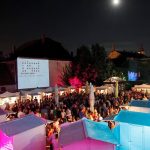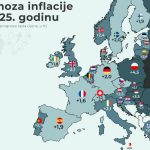With Croatian wine attracting increasing international attention, media attention focused on the Kastela region close to Split on March 3, 2015, as the great and the good (and a heavyweight wine press corps from Zagreb) took part in the 12th ‘Evening of Kastela Wines’, whose main grape variety of Crljenak Kastelanski is better known to the world as Zinfandel.
Despite having a wine tradition which pre-dates Christianity, the wines of Croatia have been relatively unknown internationally until recently, and the country’s 130 indigenous varieties have been exciting winemakers like Master of Wine Jo Ahearne, who moved to the island of Hvar recently to become the first high profile international winemaker on Croatia’s premier island.
.jpg)
The waterfont welcome from the Bedalov winery in Kastela.
Ahearne is excited by the potential of this relatively undiscovered wine region and the possibilities it presents, and there can perhaps be no better example than thediscovery in 2001 that the origins of Zinfandel being traced back to Kastela, a settlement of seven historic coastal villages nestled between two UNESCO World Heritage Sites, the old town of Trogir and Diocletian’s Palace in Split.
.jpg)
The Mediterranean as It Once Was. Bedalov also offers vineyard tastings high above Kastela, a chance to appreciate the beauty and traditions of Dalmatia.
In a fast-moving tourism country, such a discovery would have triggered a major marketing campaign. However in sleepy Dalmatia, the important link between Zinfandel and the indigenous Crljenak has not yet been taken advantage of fully — but there are signs that this is changing.
.jpg)
The view from the Bedalov konoba in Kastela, a perfect wine and beach combination.
The Crljenak Kastelanski variety had all but died out prior to the Zinfandel discovery, but enthusiastic planting has led not only to a revival of the variety, but also exciting possibilities in wine tourism for Kastela, whose recent industrial past and lack of decent hotels have blighted its tourism fortunes.
In all, some 65 Crljenak wines were entered in the competition to find the best of all, an encouraging number for a variety which had been close to extinction. Perhaps more encouragingly, however, were the efforts taken by some of the winemakers to make their products interesting and available to tourists, and the media group was treated to a diverse and fascinating tour of the wineries of Jakov Bedalov, Tonci Kovac and Neven Vuina, whose varied but traditional approaches were an enticing window into the opportunities available in wine tourism in Kastela.
.jpg)
Tonci Kovac presents his wines to the wine press from Zagreb.
An important part of the evening programme was a presentation from leading restaurateur Zoran Pejovic from Paradox Hospitality in Split. Pejovic’s first restaurant venture in Split, Paradigma, joined the exclusive club of Jeunes Restaurateur d’Europe within six months of opening, while his Wine and Cheese Bar Paradox was the first wine bar in the Dalmatian capital and today serves an impressive 37 indigenous varieties. The connection between Zinfandel and the hospitality industry in Split, just 15 minutes, is an important connection for the producers of the original Zinfandel, as is the considerable interest from local agencies in selling wine tours. These are early days, but as the winemakers get more experience and organisation, the Zinfandel connection in a waterfront Dalmatian location may prove to be the catalyst to revive the fortunes of Kastela’s tourism industry.
.jpg)
Zoran Pejovic from Paradox Hospitality delivered a thought-provoking speech from the persepctive of a restaurateur, as the Kastela winemakers seek stronger tourism and gastronomy links.
On paper, there should not be a problem attracting tourists to the seven Kastelas, each with their own picturesque waterfront setting and rich heritage. With a major international airport five minutes away, a Game of Thrones filming location, the origins of one of the world’s most popular wines and miles of idyllic coastline sandwiched between two UNESCO World Heritage Sites (the old town of Trogir and Diocletian’s Palace), the stage is set for a bright future for Kastela, although questions should be asked why it has taken so long. Questions perhaps that can be answered over a glass of Crljenak, as Kastela’s wine tourism industry takes off.
.jpg)
The best Crljenak producers pose for the media.
.jpg)
The Kovac winery included some unusual touches, part of the charm and diversity of the Dalmatian wine story, where most producers are following family traditions and still finding their way.
.jpg)
Dalmatia is a safe and family-friendly destination, whose beaches are one of its main attractions. Kastela, which is nestled between two UNESCO World Heritage sites, has 18km of coastline.

.jpg)
.jpg)
.jpg)
.jpg)
.jpg)
.jpg)
.jpg)
.jpg)







